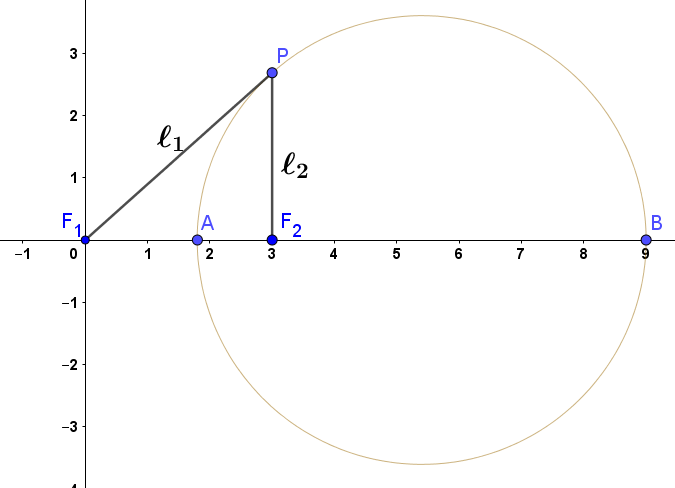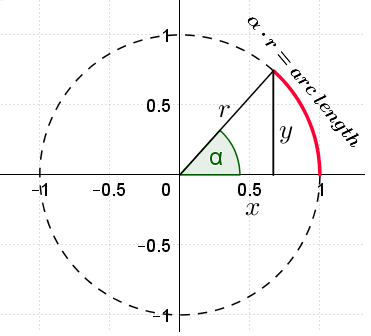Circles
Definition 1 A circle is that locus of points which is a fixed distance from a center point.
Definition 1 is the definition that we use the most. Definition 2 is attributed to Pollonius. It is used in various contexts as needed. There is a related, third definition, which is an ellipse equation with eccentricity of $1$. That, however, is quick to convert to the usual circle equation.
Definition 2 A circle is that locus of points which is a fixed ratio from two points known as the foci. This second definition needs some explanation. We begin by using an expression to restate the definition. Refer to figure 1 for symbol meanings. $$\frac{\ell_{1}}{\ell_{2}}=\frac{\Vert P-F_{1}\Vert}{\Vert P-F_{2}\Vert}=\frac{\sqrt{\left(P_{x}-F_{1x}\right)^{2}+\left(P_{y}-F_{1y}\right)^{2}}}{\sqrt{\left(P_{x}-F_{2x}\right)^{2}+\left(P_{y}-F_{2y}\right)^{2}}} \tag{1} \label{1}$$

In words, every point, $P(x,y)$, which has its distance measured from focus point F_{1} and F_{2} and for which that distance is in the ratio $\ell_{1}/\ell_{2}$ will be a point on a certain circle. For example in figure 1, point B is $9$ units from $F_{1}$ and it is $6$ units from $F_{2}$. The ratio of $9/6=3/2$. Therefore, as drawn, point $P$ must form the ratio, $$\frac{\sqrt{\left(P_{x}-F_{1x}\right)^{2}+\left(P_{y}-F_{1y}\right)^{2}}}{\sqrt{\left(P_{x}-F_{2x}\right)^{2}+\left(P_{y}-F_{2y}\right)^{2}}}=\frac{3}{2}.$$
We can see that $P_{x}=3$ by just reading it off of the graph. Therefore, from $\eqref{1}$ we can solve for $P_{y}=6\sqrt{5}/5$.
Unit Circle
Figure 2 represents the unit circle and it contains one very important concept. The arc length of any part of a circle is $Arc\,Length=radius\cdot angle=r\cdot\alpha$. Suppose $r=1$ as in Fig 2, then we accept that the circumference of the circle is $2\pi r=2\pi\cdot 1$. We also accept that the circle circumference is $\pi\cdot$ diameter and we know by definition that the diameter is $2\cdot radius$, thus the circumference is $2\pi r$. But, $2\pi$ in that expression is just $\alpha$. If $\alpha$ is less than $2\pi$ then instead of getting the length of the complete arc (a circle), we will get the length of the arc subtended by $\alpha$, or $r\cdot\alpha$.

I have carefully said that we “accept” the distance around the circle as $2\pi$. If we were from an alien society, or for that matter, merely born before the year 1706 we would probably not accept these statements, since $\pi$ is a name given to an angular unit of reference that was first used by William Jones in a paper published in 1706. (reference: Wikipedia, The Free Encyclopedia. October 13, 2015, 19:51 UTC. Available at: https://en.Wikipedia.org/w/index.php?title=William_Jones_(mathematician)&oldid=685595929.) As it turns out, to prove that the circumference of a circle is equal to $2\pi r$, is not something we will go about. Instead, we will just define the ratio $$\pi=\frac{circumference}{diameter}$$ and then perhaps be inquisitive about the value of the proportionality constant. For now, we will not even be concerned with calculating $\pi$. It can certainly be an interesting endeavour, but not now.